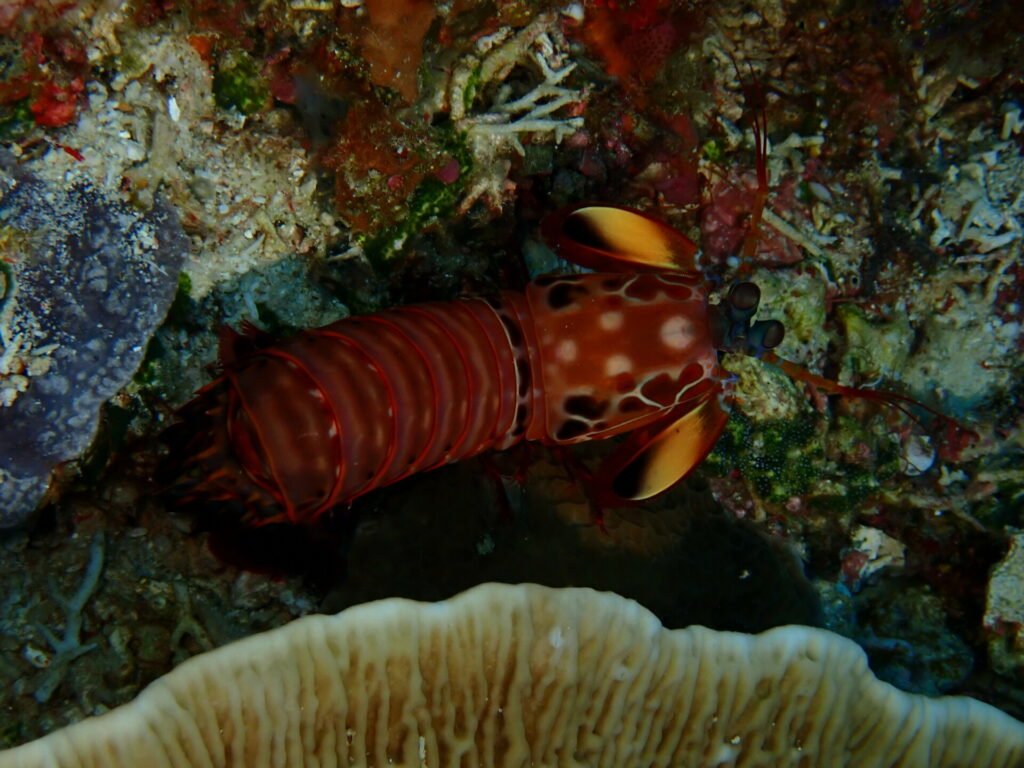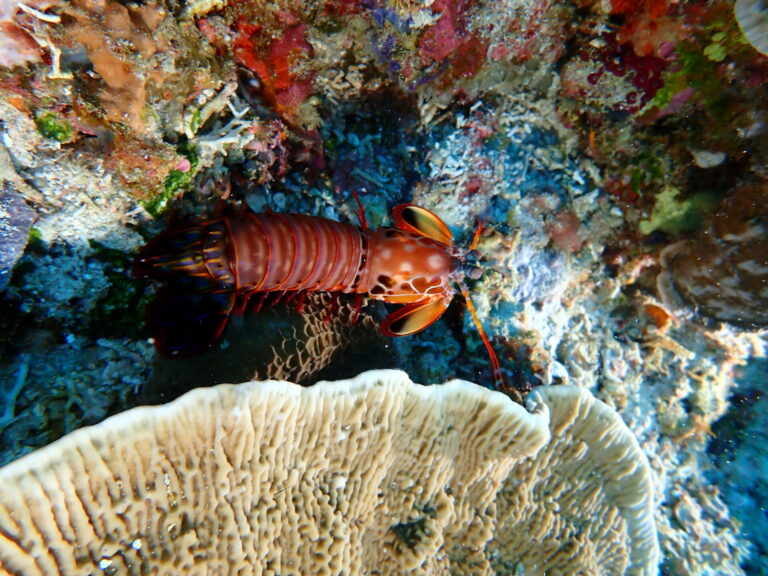Meridian Adventure Dive bring you the monthly Raja Ampat Creature Feature series: Peacock Mantis Shrimp
Diving into the vibrant waters of Raja Ampat, one can easily be captivated by the kaleidoscope of colours that inhabit the coral reefs. Among these mesmerising creatures is the peacock mantis shrimp (Odontodactylus scyllarus), a true marvel of the marine world.
A Splash of Color: The peacock mantis shrimp lives up to its name with its spectacular display of hues. From electric blues to fiery oranges, its exoskeleton boasts a palette that rivals the most vivid sunsets, making it a sought-after sight for divers and underwater photographers.
Claws of Fury: Its raptorial appendages and modified limbs near its mouth are truly remarkable. They can strike with incredible speed and force, delivering blows that can easily break through the hard exoskeletons of prey such as crabs, molluscs, and even small fish.

What makes the mantis shrimp’s strike so powerful is its unique mechanism. Unlike most animals that use muscles to generate force, the mantis shrimp employs a spring-loaded system. It stores energy in a saddle-shaped structure called the saddle within its appendages. When it releases this energy, the appendages accelerate with astonishing speed, reaching velocities comparable to a .22 calibre bullet.
This remarkable punching ability allows the mantis shrimp to access its prey’s soft tissues and create shockwaves in the water, stunning or even killing its prey. However, the force of the strike is not the only thing that makes the mantis shrimp a formidable predator. Its appendages are also equipped with sharp, pointed tips that can pierce through the shells of its prey, making them vulnerable to its powerful blows.
Eyes Wide Open: These crustaceans possess eyesight that far surpasses that of many other creatures. Their visual system is sharp and multifaceted. Each eye is a marvel of evolution, capable of perceiving depth and a wide spectrum of colours.
The mantis shrimp’s vision is awe-inspiringly complex. While humans have three types of colour receptors (cones) in their eyes, allowing us to see millions of colours, the mantis shrimp boasts an astonishing sixteen types of cones. This abundance of colour receptors enables them to see a range of colours far beyond the capabilities of most other animals.

Furthermore, the mantis shrimp’s eyes can detect polarised light, which vibrates in a single plane. This ability allows them to perceive subtle invisible contrasts and patterns in most creatures.
Hunter’s Instinct: The peacock mantis shrimp is a skilled predator that prowls the reefs for its next meal. Its lightning-fast strikes, from unsuspecting fish to armoured crustaceans, make no prey safe. With stealth, speed, and sheer brute force, it ruthlessly takes down its quarry.
Lone Guardian of the Reef: Despite its dazzling appearance, the peacock mantis shrimp is a solitary creature, staking out its territory within the labyrinthine passages of the coral reefs. It defends its home with unwavering determination, warding off intruders with menacing displays of aggression.
A Lifecycle Unfolds: Like a chapter in a never-ending saga, the life of a peacock mantis shrimp begins in the ocean’s depths. From the moment it hatches, it embarks on a journey of growth and transformation, shedding its exoskeleton repeatedly until it reaches maturity.
In Raja Ampat’s underwater kingdom, the peacock mantis shrimp reigns supreme as a testament to nature’s boundless creativity and beauty. With its dazzling colours, fearsome claws, and unwavering tenacity, it embodies the essence of life beneath the waves.
Situated in Raja Ampat, Indonesia, Meridian Adventure Dive is a PADI 5 Star Resort and winner of the PADI Green Star award. Scuba divers enjoy our professional services that have become synonymous with both the PADI and Meridian Adventure names.


